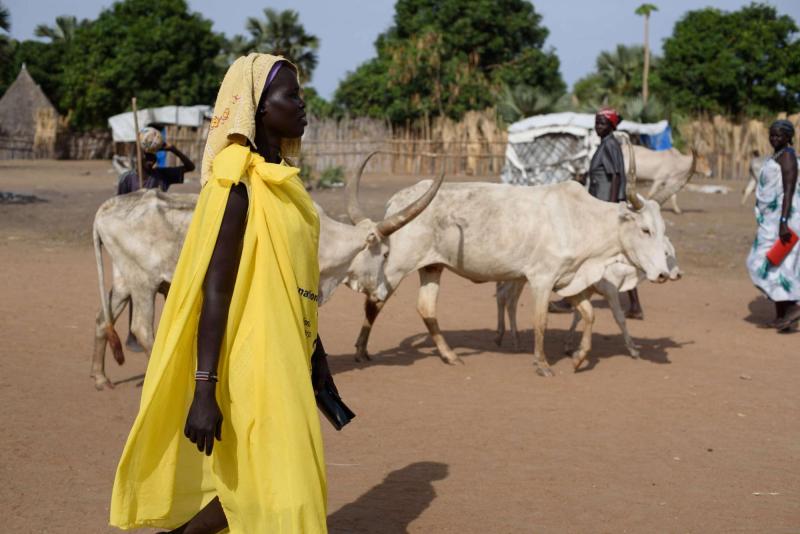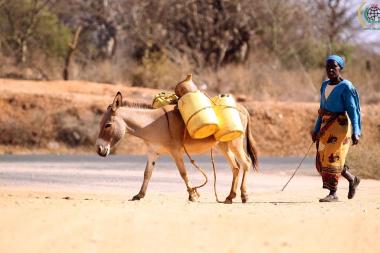Dynamism in the drylands: How pastoral livelihoods are changing in South Sudan
Volatility in South Sudan and the world’s drylands raises questions as to the long-term viability of pastoral livelihoods. A new report from SPARC begins to answer them.
While the Horn of Africa is in the midst of the longest drought in its recorded history following five consecutive failed rains, South Sudan is experiencing its own, very different crisis. Four back-to-back years of flooding have left much of the country submerged for years on end, affecting over a million households. Flooding is driving displacement and worsening an already dire hunger crisis, with the latest IPC figures estimating over 6 million people experiencing acute levels of food insecurity in the country.
At the frontline of the global climate crisis, many of the worst affected in South Sudan are pastoralists. Flooding has led to widespread livestock loss and has forced many pastoralists to trek their animals long distances in search of pasture and functioning markets. Violence, in the form of armed cattle raiding and revenge-related attacks, continues to affect pastoral communities, further limiting the ability of herders to safely graze their livestock.
Volatility in South Sudan and the world’s drylands may invite some observers to question the long-term viability of pastoral livelihoods. With humanitarian needs consistently outpacing available resources, why should the aid community continue to invest in supporting pastoral livelihoods in the face of so much uncertainty? Is pastoralism still a viable livelihood strategy in the long term? If so, what kinds of livelihood support interventions should the aid community prioritise in the drylands?
A new report from SPARC begins to answer these questions. The evidence is based on two years of interviews by SPARC researchers with 60 pastoralist households affected by the flooding crisis in South Sudan. We asked the household respondents how they are adapting to climate- and conflict-related shocks and how increasing uncertainty in the drylands may be driving changes to their perceptions of pastoralism and long-term livelihood aspirations. The following key findings emphasise that support from aid actors should match the adept and inherent flexibility of pastoralists in response to shocks observed in South Sudan.
Key Findings
Even amidst increasingly frequent and intense shocks and growing volatility in the drylands, pastoralists continue to demonstrate that they are expert at coping with uncertainty. A central feature of this resilience lies in pastoralists’ ability to adjust the balance of their livelihood activities in response to emerging threats. Pastoral livelihood systems are inherently dynamic and entail a constant process of adaptation, diversification and intensification, often on a seasonal basis, but also in response to shocks. In some cases, including in response to the ongoing flooding crisis, this may entail temporarily pursuing non-livestock activities to spread risk and diversify income streams. At first glance, the prioritisation of alternative livelihood strategies in response to shocks and emerging threats may appear to signal the declining long-term viability of pastoralism. However, it is critical to understand this dynamism as an inherent strength of the flexible pastoral livelihood system.
“We are pastoralists, but I can’t say that herding is better than business or better than farming. All of them are good, and they are complementary to each other. When livestock activities are not flourishing, farming supports the household. If farming is not doing well, maybe in the event of a flood, business supports the household. Then, when conditions improve, we go back to our livestock. Everything has its correct and necessary time.”
– Male pastoralist, BentiuNonetheless, many pastoralists’ long-term aspirations and livelihood priorities are changing due to shifting hazards and perceptions of risk. In South Sudan, flooding and persistent conflict are causing many people to re-evaluate the long-term favourability of pastoralism. Livelihood aspirations and perceptions of pastoralism may differ dramatically within communities and even within households. These differences are often linked to a variety of interacting socioeconomic factors, like age, wealth and proximity to towns and markets. Gender is especially pertinent, with women in pastoralist communities appearing to aspire to non-farm livelihoods far more often than men. In South Sudan, displacement to towns due to flooding and conflict is accelerating changes in women’s livelihood priorities by exposing them to new opportunities in markets and employment.
Livelihood support interventions must account for the diversity of these priorities. Interventions should be designed to facilitate pastoralists’ short-term strategies for addressing shocks, while also empowering pastoralists to act on their long-term livelihood priorities.
“Women who were in the cattle camps with their households ran to towns after their livestock were looted and because of this flooding. In town, some of them were able to start new livelihood activities for the first time, such as tea-making, firewood selling, vegetable selling and bread selling. Others were employed by humanitarian organisations and companies.
- Female pastoralist, BentiuConsequently, livelihood support interventions in the drylands should be designed with the explicit objective of promoting flexibility, which is inherently what makes pastoralism sustainable and resilient. This means empowering pastoralists to make informed decisions on their own terms about their livelihoods, rather than designing interventions to incentivise specific externally-defined outcomes.
Recommendations
Our research makes the following recommendations for aid actors to enable individuals and households to access a broader set of livelihood options and to make informed decisions about livelihood investments on their own terms.
Redouble investments in market-based interventions proven to build pastoralists’ resilience to shocks. When facing shocks, pastoralists often rely on selling livestock to finance alternative livelihood strategies. Promising market-based interventions i) stimulate continued trade in unfavourable conditions, and ii) are specifically designed to enable pastoralists to sell more livestock, more efficiently, and at higher prices. This may include market-based commercial destocking interventions or the use of smart subsidies or other financing mechanisms that increase available capital and enable traders to offtake more animals, for example, by hiring necessary labour and transport. It is essential that these interventions are customised to address the unique effects that different shocks have on livestock markets, as well as the root causes of pastoralists’ inability to sell animals and the underlying drivers of low animal prices. For guidance on how to design and when to implement contextualised market-based responses, aid actors should harness existing tools, such as the Livestock Emergency Guidelines and Standards (LEGS), that offer clear decision-making guidance.
Equip pastoralists with the information they need to proactively adjust their livelihood strategies ahead of shocks. When able to access timely, trustworthy and actionable information, pastoralists consulted in this study were more likely to make proactive – rather than responsive – adjustments to their livelihood strategies. Doing so may help them avert losses and recover more quickly from livelihood disruptions. Investing in multi-hazard early warning systems may be an important step to ensuring pastoralists are able to implement proactive livelihood strategies. Given the fact that distrust in formal information sources can be a deterrent to the uptake of early warning messaging, aid actors should channel information though informal social networks, which other research from South Sudan suggests are among households’ most important sources of information during crises.
Design interventions to address the distinct implications that livelihood strategies have for women’s wellbeing. The livelihood strategies households employ in response to shocks may introduce new opportunities for women, such as exposure to markets and formal education, as well as new risks, such as increased time poverty and protection risks. Livelihood support interventions should account for and seek to mitigate risks to women that are associated with various common livelihood strategies, while also redoubling efforts to ensure women are able to directly benefit from engagement in livestock value chains. Further, aid actors should ensure that investments that support women’s non-farm livelihoods accompany interventions that primarily target livestock value chains, as many female pastoralists are seeking opportunities to engage in diversified town-based livelihood activities.
SPARC will continue this line of research in the coming year in South Sudan and other drylands contexts. We welcome your feedback and look forward to sharing additional findings with you soon.
For further information, contact Alex Humphrey ([email protected])


